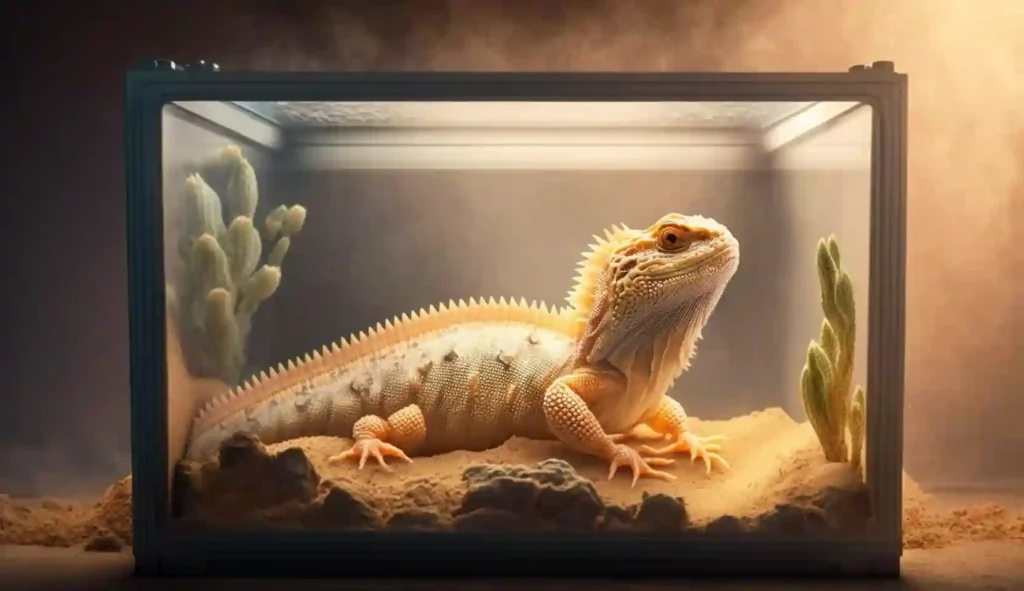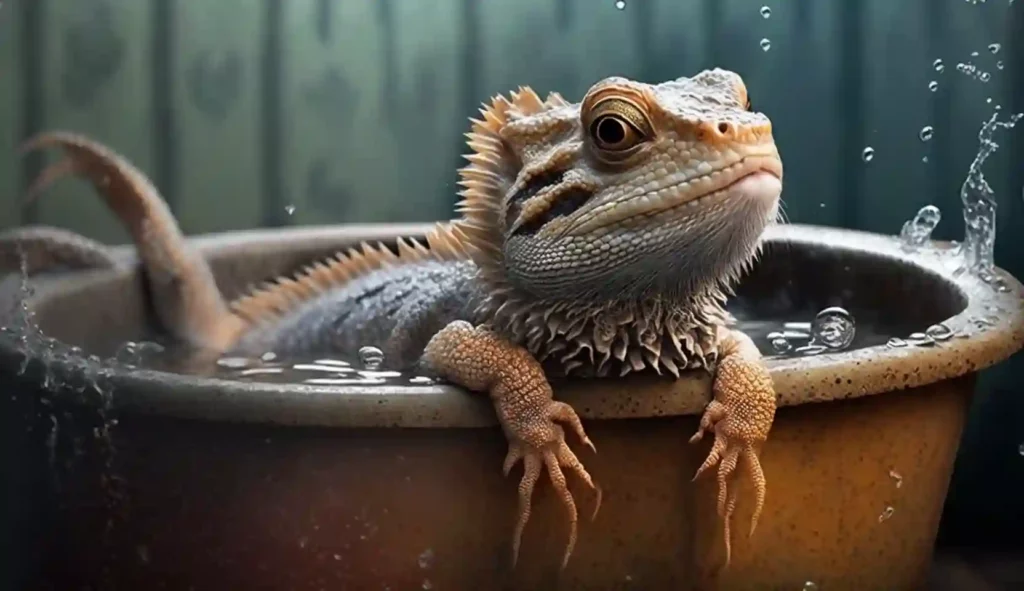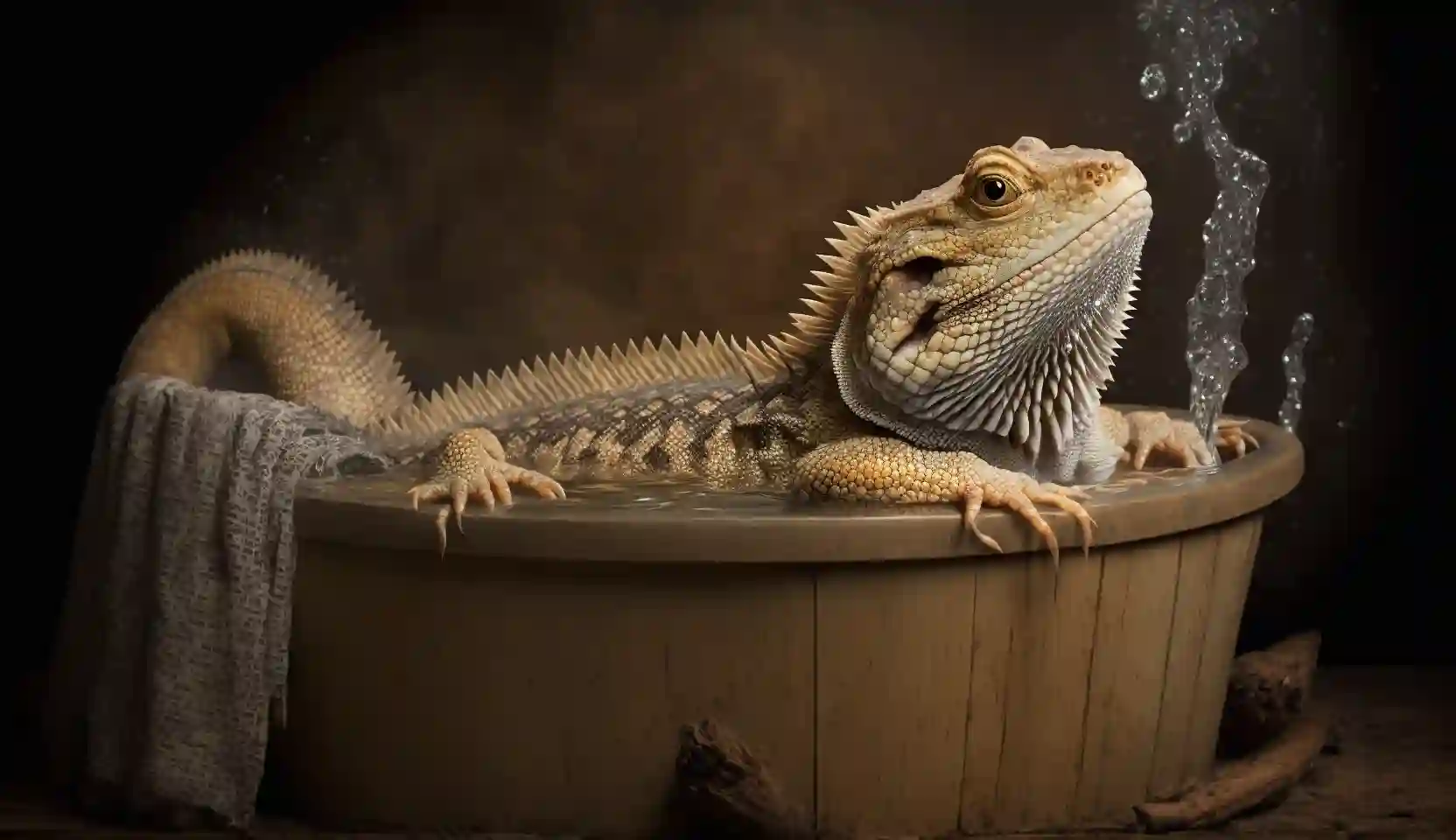The size of the tank for a bearded dragon depends on its age and size. Baby bearded dragons under 10 inches can be housed temporarily in a 20-gallon tank. However, young adults and adults should have a minimum tank size of 55 gallons, but ideally 75 gallons. Large dragons over 20 inches will do best in tanks at 75 gallons, but should really be given a tank of 120 gallons.
The ideal tank size for an adult bearded dragon is at least 4 feet by 2 feet by 2 feet.
The minimum size recommendation for a tank is 36” x 18” x 18”.
It is best to use a front-access reptile enclosure instead of an aquarium.
Types Of Tanks Suitable For A Bearded Dragon

Choosing the right tank for your bearded dragon can be a daunting task.
Like a mental puzzle, you must piece together which type of terrarium is best suited for your pet reptile’s needs.
A glass terrarium is an ideal option for displaying your scaly friend in all his glory.
It allows natural light to pass through its transparent walls, providing plenty of warmth and adequate ventilation.
Plus, the elegance of a classic glass enclosure brings out their coloration with an added touch of sophistication.
If aesthetics aren’t a top priority, then plastic or wooden vivaria are more practical solutions that still provide ample room to explore.
Metal cages should only be used as temporary housing before upgrading to a larger home while acrylic tanks offer visibility but lack proper air flow due to their enclosed nature.
Types Of Tanks To Avoid For A Bearded Dragon
When it comes to selecting the right tank size for your bearded dragon, there are a few types of tanks that you should avoid.
Plastic tanks can be inadequate since they don’t provide enough ventilation and may not be large enough for the pet.
Glass aquariums also typically aren’t suitable for bearded dragons; these often lack airflow and create too much condensation on their walls which could cause health problems in reptiles.
Small cages or terrarium kits are also inappropriate since they don’t offer sufficient space for proper movement and require frequent cleaning.
Lastly, wooden enclosures should be avoided as well because wood is difficult to clean, lacks UVB lighting needed for beardies, and isn’t easily expandable if an extra room becomes necessary.
It’s important to recognize what type of enclosure won’t work properly with a bearded dragon so that you can purchase one that will meet its needs while providing a comfortable home environment.
Factors To Consider When Purchasing A Tank

When selecting a tank, there are several factors that must be taken into consideration: type, materials, budget, and location.
The first factor to consider when looking at tanks is their size.
Tanks come in different sizes based on the number of gallons they hold; larger tanks are better suited for adult dragons while smaller ones are ideal for juvenile lizards.
It’s important to choose the correct size so your pet can move around comfortably without feeling cramped or restricted.
Another important thing to think about is the type of tank you’ll need.
Glass aquariums are popular because they allow for full visibility of your reptile and its environment, but if space is an issue plastic terrariums may be a more practical option.
Some tanks offer additional features such as adjustable basking lights and temperature control systems which might make them more suitable for certain situations.
The materials used in making the tank should also be considered carefully – glass versus plastic or acrylic?
Plastic tanks tend to require less maintenance than glass aquaria, however, they do not provide good insulation against extreme temperatures and humidity levels compared to glass enclosures.
Appropriate Dimensions For Bearded Dragon Tanks

When it comes to picking the right tank size for your bearded dragon, there are several factors that you should consider.
The size of the beardie’s enclosure will depend on its age and species as well as the type of environment they need to remain healthy and happy.
Here is a guide to help you decide what tank size would best suit your pet:
- Tank Size Measurements: Make sure the length of the tank is twice as long as your dragon’s body length and three times longer than its tail length. This allows enough space for them to move around comfortably. It also gives them plenty of room for basking spots, hideouts, and other decorations such as real or artificial plants.
- Tank Size Guide: Bearded dragons prefer larger tanks since this provides more room to explore and exercise in. A 55-gallon aquarium is typically recommended for adult dragons, while smaller juveniles may do just fine in a 20-30 gallon enclosure. Other options include cages with mesh tops or custom enclosures made out of wood and plexiglass.
- Size Requirements Dragons: Along with providing adequate floor space, make sure the height of the tank meets your beardie’s needs too! For example, arboreal species require taller tanks so they can climb up onto branches or ledges if needed. On the other hand, terrestrial varieties tend to be content with shorter enclosures that provide lots of ground cover instead.
- Tank Size Recommendations: Finally, supplementing your beardie’s habitat with proper heating and lighting fixtures is essential regardless of size requirements. UVB light bulbs should always be provided during daytime hours while a ceramic heat emitter should be used at night time temps drop below 70°F (21°C). Additionally, using an appropriate substrate like sand or reptile carpet can further enhance their living conditions by providing better insulation against extreme temperatures when needed.
How To Decorate The Tank For A Bearded Dragon?
When picking out a tank size for your bearded dragon, you should always purchase one large enough to provide them with plenty of space.
A tank that is at least 30-40 gallons in size will give them ample room to stretch their legs and explore.
| Tank Accessories | Description |
|---|---|
| Basking Spot | A flat rock or basking platform where your beardie can soak up heat from the light source |
| Hideouts | Provide places for privacy and security such as rocks, cork bark pieces, and hide boxes |
| Heating Lamp/Light | UVB emitting lights allow essential vitamin synthesis while providing warmth throughout their enclosure (ambient temperature should be between 75-85°F) |
| Substrate | Choose an appropriate substrate like sand, paper towels, or reptile carpeting which provides traction and humidity retention |
Once these essentials are set up in your bearded dragon’s tank, you can use other accessories like plants, vines, branches, artificial caves, and climbing structures to make it look more naturalistic.
What Accessories Are Needed In A Bearded Dragon Tank?
Like any home, there should be furniture and decorations that make the space comfortable and inviting—and in this case, safe.
Just as a sparkles like jewels in a castle, so too do these essential items glimmer with importance for your pet’s well-being.
The following list of needed items will help you create an enjoyable environment for your new companion:
- Water Dish: This is important for providing clean water on demand and can come in various shapes and sizes. Be sure to get one big enough for them to submerge their entire body if they wish!
- Hide Box: A hide box provides security from other animals or loud noises and gives them somewhere private to rest when feeling stressed out. Make sure it is made from non-toxic materials such as wood or plastic.
- Substrate: The substrate helps keep their skin hydrated by retaining moisture while also providing traction underfoot. Popular choices include sand, peat moss, cypress mulch, paper towels, and reptile carpeting.
- Lighting/Thermometer: These two items go hand in hand since reptiles need specific temperatures to stay healthy and happy! Lights provide heat which can then be monitored using thermometers located above the basking spot (the warmest part of the enclosure). UVB bulbs may also be necessary depending on specific requirements.
Creating a proper habitat doesn’t have to be difficult – just ensure that each item serves its purpose in keeping your pet healthy, secure, and contented.
With these essentials taken care of you’ll soon see how rewarding having a bearded dragon as a pet can truly be.
How To Do Regular Cleaning And Maintenance Of The Tank?
Now that you know what accessories are needed for a bearded dragon tank, it’s time to learn about cleaning and maintenance.
Regularly maintaining your tank is key to keeping your dragon healthy and happy.
Below is a table with supplies you will need along with instructions on how to maintain the tank:
| Supplies | Instructions |
|---|---|
| Cleaning Cloth | Use this cloth to wipe down the inside of the enclosure weekly. |
| Sanitizer | Use sanitizer to regularly clean items such as food and water bowls, hideaways, basking rocks, etc. |
| Deep Clean Solution | Every few months do a deep clean using warm water and deep clean solution or dish soap. Make sure all items have been completely rinsed off before placing them back into the tank. |
| Vacuum/Scrub Brush | When doing a deep clean use vacuum or scrub brush to get any dirt out of crevices of décor and furniture pieces like logs and plants. |
Cleaning the tank should be done at least once per week but can vary depending on the size of your setup.
During each session, focus on removing droppings from the substrate, wiping down surfaces with a damp cloth (not too wet!), changing out dirty water dishes if applicable, spot cleaning glass surfaces, refreshing hides as they become soiled over time, disinfecting non-porous décor items like fake plants or driftwood, misting live plants when necessary and more.
If you notice any bad odors coming from your dragon’s home then it may mean it’s time for a deeper clean – which means breaking everything apart and giving it an even better scrub than usual.
Heating Solutions For Your Tank
The ideal temperature should be between 78-85°F throughout the day and no lower than 65°F at night.
To achieve this, you’ll need a thermostat control unit and some type of heat source such as an under-tank heater or ceramic heat emitter.
It’s also recommended to have a basking spot that is slightly warmer than the rest of the enclosure (around 95°F).
This will help with digestion and make sure they get enough UVB exposure from natural sunlight or artificial lighting.
